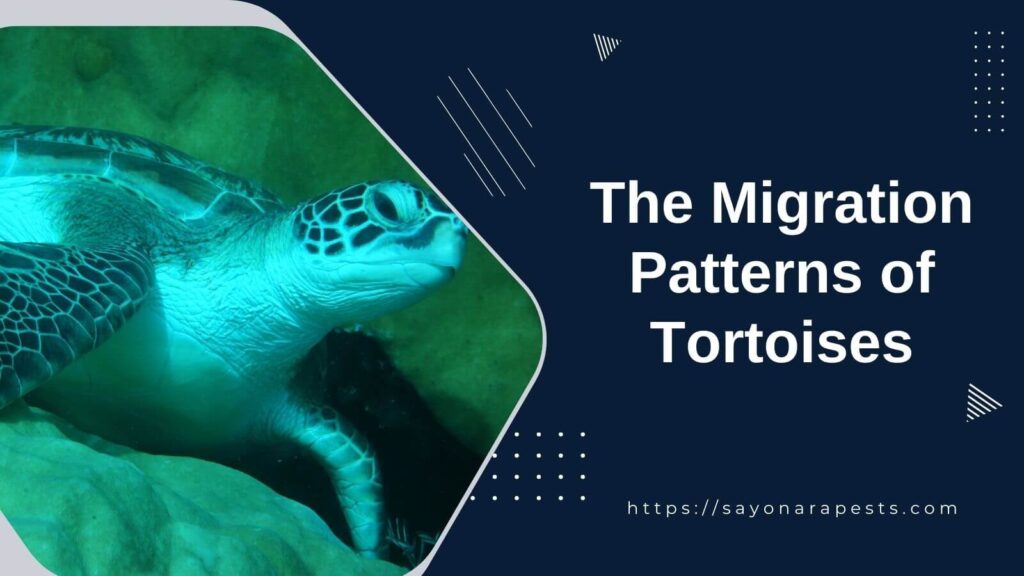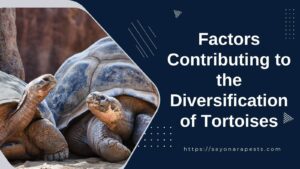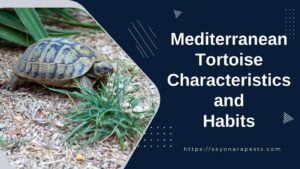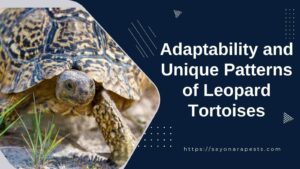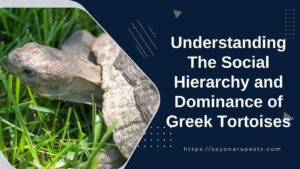Tortoises are one of the few animals in the natural world that really show what it means to be strong and determined. People have been fascinated by these amazing reptiles for hundreds of years because of how they act.
One of the most interesting things about them is how they move from place to place. Tortoise migration is a fascinating phenomenon that goes beyond instinctual movements and shows how biology, geography, and the environment work together in a complicated way.
To really understand and appreciate how complicated these migrations are, you have to dig deep into their meaning and find the hidden layers of understanding that lie within them.
Even though tortoise migration patterns vary by species and region, they often cover huge distances that surprise even the most experienced observers.
From the tall mountains of the Galapagos Islands to the vast deserts of North Africa, tortoises go on amazing journeys, crossing difficult terrain with a strong will.
These migrations are not just aimless wanderings; instead, they are very important for keeping tortoise populations going and keeping the balance of nature.
Understanding how tortoises move is very important for a number of reasons. First, these migrations tell us a lot about how these ancient reptiles have changed and what they do to stay alive.
By figuring out what causes and guides their movements, scientists can learn more about the complex systems that help tortoises survive in harsh environments and do well even when things don’t go their way.
Then, this information can be used to help with conservation efforts and keep these species from going extinct.
Also, understanding how tortoises move gives us a glimpse into how ecosystems are delicately connected. As tortoises move through different environments, they interact with many different organisms and help spread seeds, nutrients, and even smaller animals.
Their movements change where plants and animals live and how many different kinds there are of each. This is a key part of keeping the environment in balance.
By figuring out how these migration routes work, scientists can learn a lot about how ecosystems work and the complex web of relationships that keeps life on Earth going.
Also, in a time when the environment is changing quickly, it is even more important to know how tortoises move. Tortoise populations around the world are in danger because of climate change, destruction of habitat, and human activities.
By understanding their migration routes, scientists can find important places to protect habitats, mark safe passageways, and come up with effective conservation strategies.
This information gives us a glimmer of hope in the fight to keep tortoises alive and protect the delicate balance of nature.
Tortoise migration patterns are a beautiful tapestry that shows how adaptation, ecological connections, and the need for conservation are all interwoven.
Unlocking the secrets hidden in these migrations is not only a scientific challenge but also a moral duty to protect the complex web of life on Earth.
By looking at how tortoises move around, we can learn more about how resilient our planet is and how deeply all living things are connected.
Let’s start this quest for knowledge with our eyes wide open so we can see all the amazing things that are in store.
Tortoise Migration Patterns
Tortoise migration is a fascinating aspect of animal behavior. There are different kinds of migration, each with its own patterns and reasons.
These awe-inspiring reptiles go on amazing journeys, crossing large areas of land with a strong sense of purpose.
There are three kinds of tortoise migration: seasonal, opportunistic, and nomadic. Each type shows something different about how these tough animals work.
Seasonal migration
One of the most common and carefully planned ways for tortoises to move is through seasonal migration. Tortoises migrate in a way that looks like a well-choreographed ballet. They do this when the environment changes.
This great migration orchestra is led by a symphony of signs from the sky, such as the changing tilt of the Earth’s axis and changes in the length of daylight. Tortoises move through vast landscapes with a steady rhythm.
They do this because they have an instinct to look for better places to live and food.
Tortoises are the perfect example of adaptability because they move from one place to another based on the seasons. They do this with such grace that it makes you wonder how they do it.
Opportunistic migration
In contrast to how predictable seasonal migration is, opportunistic migration shows how the tortoise can take advantage of short-lived opportunities.
Unlike its more organized counterpart, opportunistic migration is not a planned course of action but rather a quick reaction to a lucky set of circumstances.
Tortoises take advantage of sudden changes in their environment, such as the appearance of a lot of food or the appearance of temporary bodies of water.
They embrace the winds of change. Their journey shows how strong and adaptable they are as they quickly go on expeditions to take advantage of opportunities that only last a short time.
Through opportunistic migration, tortoises show how well they can adapt and take advantage of temporary advantages. This shows how determined they are to stay alive.
Nomadic migration
Nomadic migration may be the most mysterious and unpredictable of the three types. It shows how the tortoise kingdom is full of wanderlust. Nomadic tortoises are driven by an insatiable desire to learn and explore.
They don’t care about rules and go where they want, even if it means crossing huge distances. Their migrations are not caused by seasonal changes or immediate opportunities.
Instead, they are driven by a natural desire to find new places. These brave travelers go on trips where they don’t know what to expect.
They wander through different landscapes, driven only by a natural desire to see the world. The tortoise’s natural desire to learn is shown by the way they move from place to place.
They are not afraid to go where they have never been before. Their wandering ways inspire awe and curiosity, bringing to mind tortoises making their way through wild places and making up their own amazing stories as they go.
The seasonal, opportunistic, and nomadic threads of tortoise migration patterns weave together into a complex tapestry that tells a rich story about the amazing depth of these reptile journeys.
Tortoises have an innate ability to adapt, survive, and explore. They can do this by following the steady rhythm of the seasons, seizing opportunities quickly, or answering the call of the unknown.
Their migration patterns are fascinating and make us think about how complicated nature is and how strong the people who live there are.
How Tortoises Navigate During Migration
Tortoises, those mysterious reptiles, travel long distances in ways that have puzzled scientists and regular people for a long time.
As they move steadily over long distances, the question arises: how do these ancient reptiles figure out how to get from one place to another?
The answer lies in an interesting way their natural instincts and a keen awareness of their surroundings work together.
Tortoises are very good at reading and using environmental cues, which is a key part of how they find their way when they migrate.
These hardy reptiles are very sensitive to small changes in their environment, like changes in temperature, humidity, or even the smell of the air.
By paying close attention to these environmental cues, tortoises can figure out the general direction they should go, which brings them closer to their goal.
During migration, tortoises rely heavily on their memory and ability to learn, as well as their ability to pick up on environmental cues.
These beautiful animals build up a complex mental map of their migration routes through a mix of instinctual memory and learning from their experiences.
This internal compass helps them find their way through a maze of obstacles, allowing them to cross vast territories that are often full of dangerous terrains and harsh landscapes.
One of the most interesting things about how tortoises find their way around is that they can sense and use the Earth’s magnetic fields.
These strange animals have an uncanny sense that lets them pick up on and understand small changes in the Earth’s magnetic field.
Tortoises can find their way and keep going in the same direction even when they can’t see any other landmarks. They do this by adjusting to the magnetic fields around them.
This interesting reliance on the Earth’s magnetic fields makes their already impressive navigation skills even more complicated.
The fact that tortoises can find their way during migration shows how adaptable and tough these ancient reptiles are.
Tortoises go on amazing journeys that defy what we know about the natural world. They do this by using environmental cues, memory, and learning, as well as the mysterious forces of the Earth’s magnetic fields.
As scientists continue to figure out how tortoises navigate, we learn more about their amazing abilities and the complex web of connections that keeps life on Earth going.
Distances Covered During Migration
Researchers and nature lovers have been interested in the distances animals travel when they migrate for a long time. These incredible journeys that different species take never cease to amaze.
Out of all the interesting animals that travel long distances, tortoises stand out as the most patient and tough.
When you look into the world of these slow but steady reptiles, you’ll find that different species of tortoises travel different distances and in different ways.
Tortoises travel a wide range of distances when they migrate. This is because they live in many different places and have different ecological needs.
From the slow-moving Galápagos giant tortoise to the quick-moving desert tortoise of North America, the difference in the lengths of their migrations is both amazing and puzzling.
Tortoises travel through deserts, grasslands, and even large parts of the ocean to find good places to lay their eggs, find food, or find the right weather.
When the distances tortoises travel during different types of migration are compared, interesting differences in how they move are revealed. Some species move short distances, usually just a few kilometers, to find food or places to nest when it’s the right time of year.
For example, the European tortoise might move short distances to find fresh food or a good place to lay eggs. These localized migrations are important ways for animals to get the most out of their resources and make sure their young offsprings live.
On the other hand, some tortoise species do long-distance migrations that test their endurance and ability to find their way. The leatherback sea turtle is famous for its long journeys across oceans.
These trips can be thousands of kilometers long. Tortoises are able to travel long distances, like these brave travelers who brave the vastness of the ocean to get to nesting beaches.
Their ability to migrate shows that they have learned a lot about the stars, magnetic fields, and ocean currents over millions of years.
There are a lot of different things that affect how far tortoises travel when they migrate. These things are interconnected with each tortoise species’ biology, ecology, and environment.
The size of a tortoise’s body, for example, can be very important. Larger tortoises have more stamina and endurance for long journeys.
Also, the availability of food, changes in temperature, and the need to reproduce are important factors that affect how these amazing reptiles migrate.
Timing and Duration of Migration
These amazing animals are born with the ability to move in time with the changing rhythms of nature. As winter ends and spring starts to bloom, tortoises wake up from their winter sleep by responding to subtle cues in their surroundings.
Different tortoise species migrate at different times, which is interesting because it shows how they have adapted to different ecosystems.
The timing of a tortoise’s migration is complicated by seasonal cues like temperature, rainfall, and the availability of food. The changes in these environmental factors are important cues that help tortoises make their long, hard journey.
For example, tortoises start their migration when the weather gets warmer and there is more food available. This helps them stay alive and have babies in the best conditions possible.
The length of time it takes tortoises to migrate is a mysterious trait that is affected by a lot of complicated factors. This complex interaction of factors shows a fascinating story of adaptation and strength.
It is important to realize that the length of migration is not a fixed thing. Instead, it is a dynamic process that is affected by many ecological and physiological factors.
Tortoises migrate for different lengths of time depending on things like how far they have to travel, whether or not there are good places to live along their route, and how their bodies work.
Some species only migrate for a few weeks or months, while others travel for many months or even years. This complicated tapestry of different times shows how well these hardy reptiles are able to adapt and find ways to survive.
When the timing and length of tortoise migration in different species are compared, a rich tapestry of differences and similarities emerges.
Ecological and evolutionary processes have shaped different migration patterns that show how species’ traits interact with the different ecosystems they live in.
Some tortoises migrate at the same time as their counterparts, but others do it at very different times. This shows how each species has developed interesting ways to adapt to its environment.
Also, the length of migration gives interesting clues about the mechanisms that drive these journeys.
Comparative studies have shed light on the different time scales and shown that tortoises have developed different ways to deal with the challenges that migration brings.
Some species have what are called “punctuated migrations,” which involve short periods of movement followed by long periods of rest.
Other species, on the other hand, have “continuous migrations,” in which they move steadily toward their destination.
Factors That Influence Tortoise Migration Patterns
Environmental Factors
Migration patterns of tortoises are interesting and are affected by a lot of different things, but environmental conditions play a big role.
Temperature, humidity, rainfall, and changes in the climate are some of the main things that affect how these interesting creatures move.
Temperature is one of the most important environmental factors that affect how tortoises move. These ancient reptiles have to move in a certain way based on the temperature.
Tortoises are ectothermic, which means that their body temperature is controlled by heat from the outside. Because of this, they look for places where the temperature is just right for them to live and breed.
Changes in temperature patterns can have a big effect on their migration since they have to move to find the right temperature.
Another important thing that affects how tortoises move is humidity. Different species of tortoises need different amounts of humidity, so they often move to places with the right amount of moisture for them.
High humidity is important for staying hydrated and keeping from getting dehydrated, especially in dry places. Because of this, tortoises are very good at noticing changes in humidity and changing their migration routes to match.
Tortoises also move a lot based on how much rain there is and how much water is available. Like a lot of other animals, tortoises need water to stay alive. Rainfall makes sure that water is available, which is important for keeping them hydrated and alive.
So, tortoises may go on migrations to get to places where it rains more or where there are lots of water sources.
Tortoises may change their migration routes to find better places to live if the way it rains changes because of things like seasonal changes or climate change.
When it comes to tortoise migration patterns, climate change is a major factor that can have a big effect. Tortoises face a number of problems as the Earth’s climate continues to change.
Climate change affects these reptiles in many ways, such as by making temperatures rise, changing the way it rains, and destroying their habitats.
Changes in the environment can make it harder for tortoises to find the right temperatures, humidity levels, and water sources, so they have to adapt and change their migration patterns to stay alive.
Food Availability and Water Resources
The things that make these migrations happen are complex and interconnected. They involve a delicate balance of ecological and environmental factors.
One important factor in tortoise migration is the availability of food and water, which is what drives them to move.
The changing seasons change how much food is available to tortoises at different times of the year. Because tortoises adapt to their environments, which are always changing, these seasonal changes play a big role in how they move.
During times when there was a lot of vegetation, these ancient reptiles usually stayed in the same places to eat, taking advantage of the rich resources they had.
But as the seasons change and food becomes harder to find, tortoises have an amazing instinct to move to better places to eat. They do this by going on long journeys.
Water is one of the most important things for all living things, and it has a big impact on how tortoises move. Because water sources aren’t always available in different places, tortoises have to move a lot to quench their thirst and make sure they don’t die.
Their journeys to find water can cover a lot of ground and last for a long time. Tortoises often have to go through dangerous landscapes and tough obstacles to get to their watery destinations.
This takes a lot of stamina and determination.
Drought, which is a natural event that happens when it doesn’t rain for a long time, has a big effect on how tortoises move around. When there is a drought, there isn’t enough food or water for tortoises.
This is a dangerous situation that needs to be fixed right away. In response, these hardy reptiles use their natural instincts to migrate and go on dangerous journeys in search of better places to live.
Drought has two effects on tortoise migration: it changes the way they find food and makes them urgently look for water sources, which often leads to migrations that have never happened before in parts of the world that have never been explored.
Habitat Destruction and Fragmentation
Deforestation is very bad for tortoises because it destroys important parts of their habitat and upsets the delicate balance they need to live. As people keep moving into green forests, tortoises lose their homes, food sources, and nesting sites.
When something like this happens, it throws off their migration patterns, and the tortoises that are forced to move to look for new ways to travel and new places to live.
Also, the slow growth of cities and the construction of roads have made it impossible for tortoises to move around as they used to.
The unstoppable growth of concrete jungles and the unstoppable ribbon of asphalt cut off the once-seamless connections between the tortoises’ ancestral domains, breaking up their homes into small, separate pieces.
The tortoises are confused and stuck in smaller and smaller areas of land because of these big problems. This makes it harder for them to stay alive.
The tortoises’ lives are affected by how their habitats are broken up, which has a ripple effect on how they move around. The broken-up landscape throws off the tortoises’ sense of direction, forcing them to find their way through places they have never been before.
This changes the paths they use to migrate. When habitats aren’t connected, they can’t share genes and keep their ecosystems in balance, which is important for their long-term survival.
Also, the lack of suitable habitats makes it harder for them to find enough food, which hurts their overall health and makes it harder for them to have babies.
Case Studies of Tortoise Migration Patterns
Galapagos Tortoises
Researchers and conservationists have been interested in the mysterious world of tortoise migration patterns for a long time. The Galapagos tortoises are one of the most interesting examples of these beautiful animals.
Their migration habits have piqued scientists’ interest and led to a lot of research into how they affect the environment. Scientists are on a long and difficult journey to figure out how Galapagos tortoises migrate.
They are determined to find out the secrets of these ancient travelers.
The Galapagos tortoise population is very diverse and unique to the islands. It also has many interesting migration patterns. These amazing animals travel long distances across the Galapagos Islands to find the best food and places to nest.
Their movements are closely tied to the availability of food, water, and good places to live. This, in turn, affects how their populations are spread out and how they change over time.
Studying these migration patterns tells us a lot about how Galapagos tortoises have changed over time and how well they can adapt to their environment.
The main thing that affects the Galapagos tortoise migration is the environment. The availability of food resources, which changes with the seasons and with the amount of vegetation, is a strong reason why they move long distances.
Also, weather patterns like rain and changes in temperature have a big effect on where suitable habitats are, which changes the routes and destinations of tortoise migrations.
Understanding how the environment and tortoise movement work together is important for figuring out how vulnerable these species are to climate change and disturbances caused by people.
Scientists use a wide range of research methods to figure out the details of Galapagos tortoise migration.
Traditional methods, like radio telemetry and mark-recapture studies, give us important information about how tortoises move, how big their populations are, and what each individual does.
For these methods, transmitters are put on tortoises and their movements are tracked. Tortoises are also caught and tagged so that their future migrations can be tracked.
Also, new technologies like satellite tracking and genetic analysis make it possible to study tortoise migration on a larger scale and learn more about how different populations are connected genetically and how genes move between them.
In the past few years, conservation efforts to protect Galapagos tortoise populations and their migration patterns have gained a lot of steam.
Due to the important role, they play in ecosystems and their status as “flagship species,” conservation groups and government agencies have worked together to set up protected areas and put in place strict management plans.
Conservation efforts focus on keeping important habitats for tortoises, reducing disturbances caused by people, and reducing the effects of invasive species on tortoise populations.
Also, public awareness campaigns and education programs try to teach people how to be good stewards and how important these beautiful animals and their migratory behaviors are.
Desert Tortoises
The desert tortoise is a unique animal that lives in large, dry areas where the hot sun beats down relentlessly on the dry ground. It is a symbol of strength and perseverance.
Researchers and conservationists are interested in the desert tortoise because it has a long history and does interesting things. It draws them into a world that is mysterious and complicated.
Studying how desert tortoises move has become an important part of understanding the delicate balance of these ecosystems and coming up with good ways to protect them.
The desert tortoise population is spread out across dry areas. They have interesting migration patterns that are closely tied to their instincts for survival and the way their habitats change over time.
These wandering reptiles go on amazing trips over long distances in search of food, water, and good places to lay eggs.
Their movements are not random; instead, they are a careful response to environmental cues and the rise and fall of resources.
By looking at these migration patterns, scientists hope to learn more about how desert tortoises and their environment work together.
The way desert tortoises move is largely determined by a number of environmental factors. Changes in temperature, seasonal rain, the distribution of plants, and the availability of water sources all play a role in how they decide where to go.
These tortoises are very aware of their surroundings and use clues from their senses to find their way when they move.
For example, changes in temperature and humidity force them to look for better microhabitats, which helps them stay alive in harsh conditions.
The desert tortoises and their environment have a complicated dance that shows the complex web of ecological dependencies at work.
Researchers use a wide range of research methods to try to figure out why desert tortoises move in such mysterious ways. Traditional field observations can tell us a lot about how the tortoises move, where they like to live, and how the population as a whole works.
With this hands-on method, scientists can write down behavior patterns, keep track of individual tortoises, and find connections between behavior and environmental factors. Technology has also changed the way people study tortoise migration.
With GPS tracking devices and satellite telemetry, researchers can get accurate information about how tortoises move over long periods of time.
By combining these methods, researchers can find out the hidden details of how tortoises move, which can lead to better ways to protect them.
Protecting desert tortoise populations and the way they move has become the most important goal of conservation efforts. Human activities, habitat destruction, and climate change are making it harder for these reptiles to live in balance with their harsh environment.
In response, many projects have been started to help desert tortoises deal with the problems they face. These include creating protected areas, restoring habitats, educating the public, and working together with local communities.
Conservationists try to protect both the desert tortoise populations and the complex migration patterns that keep them alive. They do this through research, policy, and working with the community.
African Spurred Tortoises
The African spurred tortoise, or Geochelone sulcata as it is called by scientists is a fascinating animal that lives in the vast Sahel region of North Africa. These tortoises are known for how big they are and how long they live.
They are also one of the species that move around the most. Scientists have done a lot of research to find out what makes them move and how they do it.
This has helped them understand the complexities of their migration patterns.
African-spurred tortoises move in ways that are largely determined by their environment. Seasonal changes, the availability of resources, and the weather have a big effect on these hardy animals.
During the dry season, when food and water are scarce, spurred tortoises travel long distances to find better places to live.
They are born with the ability to notice and respond to environmental cues, which helps them adapt to and survive in environments that are always changing.
Researchers use a variety of methods to study how African spurred tortoises move. They use both traditional field observations and new technology.
Satellite tracking systems have become very useful because they can show where tortoises are in real-time and over long distances.
By putting transmitters on certain individuals, scientists can track their migration routes, find key stopover points, and learn more about which habitats they prefer.
Protecting African spurred tortoise populations and their delicate migration patterns requires a lot of conservation work. Because of habitat loss, poaching, and the illegal pet trade, the survival of these well-known reptiles is in danger.
Conservation groups work with local communities to protect important habitats, create wildlife corridors, and spread the word about how important it is to keep these ancient migratory routes intact.
Conservation efforts help keep African-spurred tortoises around for a long time and improve the health and diversity of the ecosystems they live in.
The Role of Technology in Studying Tortoise Migration Patterns
GPS Tracking Devices
With the help of new technology, the complicated field of studying how tortoises move has changed in ways that have never been seen before.
Among the many technological advances that have changed this field, GPS tracking devices have become one of the most important tools.
They give scientists a look into the migration routes of these ancient reptiles that they have never had before. How GPS tracking devices work is a fascinating tapestry of scientific progress and accuracy.
At the heart of GPS tracking devices is a network of satellites in orbit that work together to provide accurate geolocation data in real-time.
These devices use a method called trilateration, which involves getting signals from more than one satellite and using the time it takes for the signals to reach the device to figure out where it is.
Through this complicated dance of signals and calculations, GPS tracking devices reveal a world of geographical coordinates. This lets researchers track the tortoises’ migration paths with amazing accuracy.
The use of GPS tracking devices to learn about how tortoises move is nothing short of revolutionary. By putting tiny GPS transmitters on these tough animals, scientists can learn more than ever before about their movements, behavior, and environmental preferences.
As tortoises move across large areas and through different ecosystems, GPS tracking devices follow them and record every detail of their journeys.
Researchers can use this technology to find important migratory corridors, track how habitats are used, and figure out the mysterious factors that affect tortoise movements.
GPS tracking devices have a lot of potential, but they also have some problems that researchers have to deal with. A big problem is that you have to choose between accuracy and battery life.
Since tortoises can move for months or even years, the battery life of GPS trackers becomes a very important issue.
Finding a good balance between the need for longer data collection times and the power needs of these devices takes careful thought and creative solutions.
Also, GPS signals can be less reliable if there is a lot of vegetation, the ground is rough, or there is signal interference. Tortoises may wander into places where GPS signals have a hard time getting through because of thick vegetation or a complicated landscape.
This can lead to inaccurate or incomplete data. To get around this problem, researchers often use other tracking methods, like radio telemetry or satellite imagery analysis, to fill in the gaps and get a full picture of how tortoises move around.
In the end, the use of technology, especially GPS tracking devices, to study tortoise migration patterns shows how scientific innovation can change the world.
These devices give researchers a “virtual window” into the mysterious world of tortoise migrations, allowing them to solve mysteries and learn more about the ecological factors that affect the way they move.
Even though there are some problems, the constant search for improvements in tracking technologies helps us learn more about these ancient travelers and shows how important it is to use technology in wildlife research.
Radio Telemetry
Among the many technological tools used, radio telemetry stands out as a pioneering technique that has helped us learn a lot more about how tortoises move.
Radio telemetry is based on attaching radio transmitters to individual tortoises. This lets scientists follow the tortoises’ movements over long distances.
This technology uses the triangulation method, which means that the signals sent out by the transmitters are picked up by receivers that have been strategically placed around the study area.
Researchers can figure out where the tagged tortoises are by looking at the strength and direction of these signals.
Radio telemetry can be used in a lot of different ways to study tortoise migration patterns. First, this technology lets researchers find out important information about the tortoise migration routes and times.
Scientists can find common paths and seasonal changes in migration patterns by watching the movements of many different individuals.
This information is very important for figuring out what makes tortoises move, like the weather, the availability of food, and where they can live best.
Also, radio telemetry makes it possible to find specific places where animals stop along their migration routes and find food.
Conservationists can protect and restore habitats that are important for the survival of migratory tortoise populations if they know where the most important places are.
Also, the data collected through radio telemetry can be used to make decisions about how to use and manage land. This makes sure that human activities don’t interfere with or slow down tortoise migration.
Radio telemetry has many benefits, but it also has some downsides. One of the biggest problems is how expensive it is to buy and take care of the equipment that is needed, like transmitters, receivers, and antennas.
The cost goes up even more because the data needs to be handled and analyzed by skilled people. Because of this, doing large-scale radio telemetry studies can be expensive and may require funding or help from outside sources.
Another problem is that the transmitters might change the way tortoises act and how their bodies work.
The weight and placement of the devices can change how the tortoises move and act in their natural way, which could change how they migrate.
Researchers must carefully think about these things and take steps to limit any bad effects on the people in the study.
Technology, especially radio telemetry, has been very important in helping us learn more about how tortoises move.
Radio telemetry has helped scientists figure out how tortoises migrate by giving them precise location information and letting them track individual tortoises over long distances.
Even though this technology has some problems and limitations, it has helped us learn more about tortoises and their migration patterns.
This has helped with conservation efforts and given us a better understanding of these amazing animals.
Remote Sensing Techniques
Remote sensing is the process of getting information from a distance and figuring out what it means. This is often done with the help of satellite imagery, aerial photography, and other sensor-based technologies.
This summary will go into detail about the different parts of remote sensing techniques, how they can be used to study tortoise migration patterns, and the limits of their use.
Researchers can study tortoise migration patterns with a level of accuracy that has never been possible before thanks to remote sensing techniques.
These techniques give a full picture of how tortoises move in space and time, shedding light on important things like migration routes, stopover spots, and habitat preferences. Researchers can keep track of tortoise populations in large areas by using remote sensing.
This helps them deal with the fact that some habitats are large and hard to get to. By being able to collect data from a distance, scientists can get useful information while disturbing the tortoises’ natural behavior and habitats as little as possible.
Remote sensing techniques can be used to study tortoise migration patterns in many different ways and in many different areas of research. For example, satellite imagery and aerial photography give researchers a bird’s-eye view of the landscape.
This lets them find and map places where tortoises can live along their migration routes. This information is very important for conservation efforts because it helps find important places that need to be protected and managed.
Also, remote sensing makes it easier to figure out how vegetation and land cover are changing, which has a direct effect on tortoise habitats.
By looking at satellite data over time, researchers can see if there is a link between environmental factors and the way tortoises move, which can help them figure out what makes them move.
Even though remote sensing techniques have come a long way, there are still some things that can’t be done with them.
First, the spatial resolution of satellite imagery and aerial photography may not always be good enough to see small details of how tortoises act, especially when smaller species or individuals are being studied.
This can make it harder to find migration routes and map habitats with high accuracy and precision.
Also, the temporal resolution of satellite data may make it hard to catch short-term or random migratory events, which makes it harder to study some parts of how tortoises move when they migrate.
Also, figuring out what remote sensing data means takes a lot of knowledge and skill, and the data may be wrong or uncertain, so validation and ground-truthing are very important.
The most important thing we can do to learn about tortoises is to study their migration patterns using technology, especially remote sensing techniques.
Researchers can learn a lot about how tortoises move by using satellite imagery, aerial photography, and other sensor-based technologies.
This helps them figure out their migration routes and where they like to live.
Even though there are some problems with remote sensing techniques, they offer new ways to protect and manage wildlife that has never been done before. This lets us protect and keep these ancient wanderers for future generations.
Conservation Efforts to Protect Tortoise Migration Patterns
In recent years, conservation efforts that try to keep tortoises’ migration patterns safe have gotten a lot of attention. Tortoise habitats need to be kept and fixed up if they are to live for a long time.
Understanding the ecological importance of protecting and restoring tortoise habitats is important for keeping the ecosystems in which they live in a delicate balance.
You can’t say enough about how important it is to keep tortoise habitats safe. Different parts of these unique reptiles’ lives, like nesting, feeding, and hibernating, depend on certain environments.
Human activities, like building cities, cutting down trees, and making more land available for farming, have slowly moved into and broken up these important habitats.
So, tortoise populations are facing problems that have never been seen before. Loss of habitat is a big reason for their decline.
Experts and conservation groups have come up with ways to restore and manage habitats to deal with this important problem.
The goal of these methods is to rebuild or improve tortoise habitats, making sure they are suitable and making it easier for tortoises to move between different areas.
Habitat restoration involves fixing up damaged areas, putting back native plants, and taking steps to improve the quality of the soil and the amount of water available.
By fixing up and making more room for tortoise habitats, these projects aim to restore important corridors and help tortoises move freely during their migrations.
Several successful habitat conservation and restoration projects have shown how important these kinds of efforts can be.
In some places, protected areas have been set up to keep tortoise habitats safe, with strict rules to keep people from getting in the way and help native plants and animals recover.
Habitat restoration projects have been a lot easier to carry out when government agencies, non-profit groups, and local communities work together.
Through thorough research, monitoring, and public awareness campaigns, these projects have helped tortoise populations grow and their migration patterns get stronger.
Also, the use of modern technologies has made habitat conservation and restoration efforts much better.
Scientists can make accurate maps and analyses of tortoise habitats using Geographic Information Systems (GIS) and remote sensing tools. This helps them find the most important places to protect and restore.
Also, using genetic data and population modeling has helped us learn a lot about how tortoise populations are connected and how different their genes are, which is important for making good conservation plans.
In the end, protecting tortoise migration patterns requires working together to protect and fix up their habitats. It is very important to understand how important these habitats are to keeping tortoise populations alive.
We can help tortoises live for a long time by using new ways to restore and manage their habitats and by learning from conservation efforts that have worked well in the past.
This will help us keep the tortoises’ amazing migration patterns and make sure they will live for a long time.
From dry deserts to lush rainforests, these ancient animals travel long distances, defying expectations and showing us how strong life is.
By learning about and appreciating how they move, we can learn a lot about the delicate balance of ecosystems and how species are all connected.
Migrations by tortoises are important for a lot more than just their own survival. As they move through different landscapes, they spread seeds, change the way plants grow, and contribute to the health and diversity of the places they live.
Their movements make paths for the exchange of genetic material, which makes them more able to deal with environmental problems.
Looking ahead, future research has a lot of potential to help us learn more about how tortoises move.
With advanced tracking technologies like GPS and satellite telemetry, we can follow their movements with an accuracy that has never been seen before.
This important information can be used to make conservation plans and help find and protect important habitats along their migration routes.
Also, because climate change is a serious threat to ecosystems all over the world, it is even more important to study how tortoises move.
By understanding how these amazing animals respond and adapt to changes in their environment, we can make targeted conservation efforts to lessen the effects of climate change and make sure that both tortoises and the ecosystems they live in will survive.
In conclusion, studying tortoise migration patterns not only reveals the beauty of nature but also shows how important it is to protect it.
With their ancient knowledge, these humble travelers remind us that all living things are connected and that it is our job to protect the delicate balance of life on Earth.
We can create a sustainable future where tortoises and their migrations thrive by doing more research, raising awareness, and working together to protect them. Their presence will make our world a better place.

